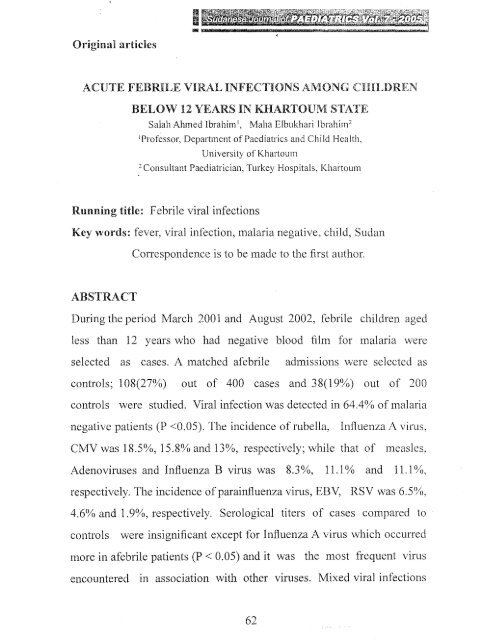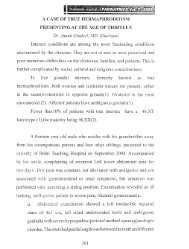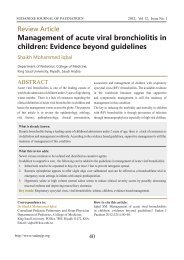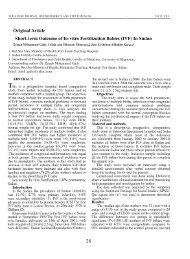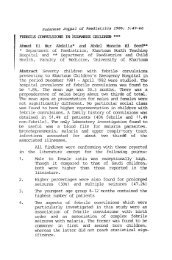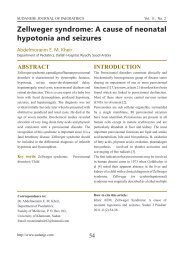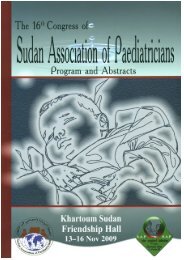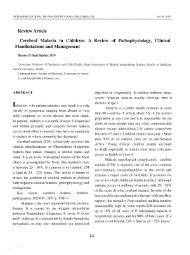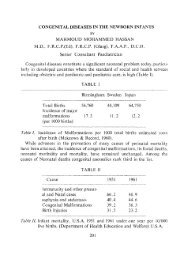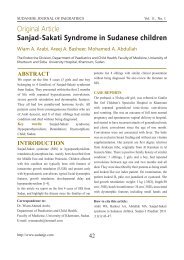Acute febrile viral infections among children below 12 ... - Sudanjp.org
Acute febrile viral infections among children below 12 ... - Sudanjp.org
Acute febrile viral infections among children below 12 ... - Sudanjp.org
You also want an ePaper? Increase the reach of your titles
YUMPU automatically turns print PDFs into web optimized ePapers that Google loves.
I-------------------------------------occurred in 21(19.4%) patients. Viral infection was implicated in 30.5%and 15.1% of cases of respiratory tract <strong>infections</strong> and. gastroenteritis,respectively. About 10% and 13.3% of infants less than three monthswere found to have significant IgM titers of Rubella & CMVrespectively. This raises the possibility of congenital (maternaltransmitted) infection. The study revealed that no difference in theincidence of <strong>viral</strong> infection between <strong>febrile</strong> and a<strong>febrile</strong> <strong>children</strong>(p= 0.3423) and that the clinical presentation of certain <strong>viral</strong><strong>infections</strong> e.g. rubella, influenza etc ... is not different from thatreported in literature, mostly presenting with symptomatology of respiratory<strong>infections</strong>.Introduction:Virology has become an increasinglyimportant field of medicinein the past decades. Many infectious diseases were once of unknownetiology can now be linked to specific <strong>viral</strong> pathogens.New methods fordiagnosing and treating <strong>viral</strong> diseases are being developed. In addition,Anti<strong>viral</strong> therapy or prophylaxis is available for many of these <strong>viral</strong><strong>infections</strong>' .Epidemics of acute illness have been reported to occurfollowing heavy rainfalls in areas where arbo<strong>viral</strong> pathogens are endemic".The clinician'sability to distinguish between parasitic, bacterial and <strong>viral</strong>such outbreaks is often difficult' and the diagnostic dilemmas are furthercomplicated by a lack of medical technology in developing countries -Sudan is no exception. Consequently, the relative importanceof different63
and IgM were also determined for following viruses: 1- Respiratorycyncytialvirus. 2- Influenza viruses A&B. 3- Human parvo B 19 virus. 4- Adenovirustype 5. 5-Parainfluenza A virus. 6- Rubella virus. 7- EpstienBarr virus 8- Cytomegalovirus.and 9- Influenza B virus.Results:Although all the samples were sent abroad for analysis, unfortunately - forsome technical reasons - results obtained included 108 from cases and 38of controls. Table.1 shows the laboratory diagnoses of cases and controlgroups. Among cases, malaria was detected in 16(14.8%) and significanttiters for one or more than one virus were detected in 58(53.7%),while in control group, malaria was detected in 2(5.2%) and significanttiters for one or more than one virus were detected in 22(57.9%).Significant <strong>viral</strong> titers for one or more than one virus were detected in5(31.2%) of malaria positive cases, while 11(68.8%) had insignificanttiters for any of the tested viruses.In malaria negative cases, significant<strong>viral</strong> titers were detected in 58(64.4%), while insignificant titer comprised32(35.6%) cases. The difference between the two groups is significant (Chisquare 6.15, P < 0.05).65
Table.I Laboratory diagnoses of cases and control groupsLaboratory cases ControlDiagnosis group groupn(%)n(%)Viral 58(53.7) 22(57.9)Non malaria 32(29.6) 14(10.5)Non <strong>viral</strong>Malaria 16(14.8) 2(5.2)Not done 2(0.9) 0(0.0)Total 108(100.0) 38(100.0)Chi square = 3.34, P = 0.3423Table.2 shows the serology of malaria-negativecases group. Rubellahad the highest frequency of20(18.5%)cases, Influenza A virus comprised15(15.8%), CMV 13(13%); <strong>12</strong>(11.1%) for each of Adenovirusesand Influenza B virus, IgM measles 9(8.3%), Parainfluenza virus 7(6.5%),EBV 5(4.6%) and 2(1.9%) cases were significant for RSV.ParvovirusB 19 was detected in only one case; this was excluded from the analysisdue to the positive Malaria film.66
Table.2 Viral serology of malaria negative cases group.*IgG&IgM number of 0/0titercasesRubella 20 18.5Influenza A 15 15.8CMV 13 13.0Adenoviruses <strong>12</strong> 11.1Influenza B <strong>12</strong> 11.1IgM measles 09 08.3Parainfl uenza 07 06.5EBV 05 04.6RSV 02 01.9* Significant titerTable.3 shows distribution of cases with significant <strong>viral</strong> titers withtype of disease. The first percentage column was calculated from allthe 108 cases while the second percentage is the percentage of eachdisease from the cases with significant <strong>viral</strong> titers; 33 of cases hadrespiratory tract <strong>infections</strong> who comprised 30.5% of all cases groupand 64.9% of cases with significant <strong>viral</strong> titers. The cases who hadgastroenteritis Cn=16) comprised 15.1% of all cases and 27.6% ofcases with significant<strong>viral</strong> titers.The detection of significant <strong>viral</strong> titers of the tested viruses<strong>among</strong>cases with respiratory tract <strong>infections</strong> CARl) and gastroenteritis COE)is67
shown in Table 4.Significant Rubella titers were detected in13(<strong>12</strong>%) and 6(7.4%) cases of ARI and GE, respectively. CMV, InfluenzaB, Influenza A and Parainfluenza virus were detected in 9( 8.3%),9(8.3%), 7(6.4%) and 6(5.5%) ARI cases, respectively. Influenza B titreswere detected in 7(6.4%) cases of GE.Table3 Disease distribution of cases with significant <strong>viral</strong> titersDisease n Percentage' Percentage' n=108n=58Significant:ARI 3330.5 56.9Gastro- 1615.1 27.6enteritisOthers 9 8.3 15.5Non: 60 46.2SignificantTotal 108 100.0 100.0IPercentage calculated from the total case group (n= 108)2Percentage calculated from the total cases with significant <strong>viral</strong> titers(n=58).68
Table.j Distribution of <strong>children</strong> with significant <strong>viral</strong> titers <strong>among</strong>cases with respiratory tract infection (ARI) and gastroenteritis (GE).*IgG & IgM ARI cases GE casesTiter n (%) n (%)Rubella 13 (<strong>12</strong>.0) 8 (7.4)CMV 9 (8.3) o (0.0)Influenza B 9 (8.3) 7 (6.4)Influenza A 7 ( 6.4) 4 (3.7)Parainfluenza 6 (5.5) 2 (1.8)Adenoviruses 5 (4.6) 4 (3.7)IgM Measles 4 (3.7) 4 (3.7)RSV 2 (1.8) 1 (0.9)EBV 2 (1.8) 1 (0.9)* Significant titer.Discussion:Excluding<strong>children</strong> with positive blood film for malaria <strong>among</strong>cases (n=16) and controls (n=2), the study showed that significant titersfor one or more than one viruswere detected in over half of the casesand controls. With exceptionof Influenza A virus titre, all the P valueswere insignificant and this can be explained by asymptomatic or recentinfection". This also indicates that there is no difference in the incidenceof <strong>viral</strong> infection <strong>among</strong> <strong>febrile</strong> and a<strong>febrile</strong> patients. However, whencomparing the significant and insignificant <strong>viral</strong> titers in patients withpositive negative blood film for malaria, it is clear that there was69
a significant difference (P
I•••in 8.3% of cases. Among those, one case was recently vaccinated andtwo others were not vaccinated yet.. Skin rash was detected in only onethird; this is could be explained by the early presentationof cases. Similarclinical presentations were reported in the literature 13.Significant Rubella virus IgG & IgM titers were detected in aboutone fifth of cases. Recent serologic surveys have similarly indicatedthat 10-20% of young adults are susceptible to Rubella and the degreeof susceptibility is due predominantly to underutilization of vaccine in thepopulation14; but in Sudan the higher percentage is mainly due to thevaccine unavailability and possibly high rate of virus circulation.The mean age of the <strong>children</strong> in the study was 15.8 months. However,one quarter of themwas <strong>below</strong> six months of age and two were lessthan two months old. This raises the possibility of maternally transmittedRubella antibodies although these cases did not show any featureof congenital infection!". Significant Cytomegalovirus IgG & IgMtiters were also detected III over one tenth of cases and thisrepresented 8.3% of respiratory <strong>viral</strong> infection. This rate is twicethat reported III study that done in Texas where the VIruSwas detected m 4% of cases of respiratory tract <strong>infections</strong>'s.Respiratory tract <strong>infections</strong> and pallor are thepresentation of two third of cases. Hepatomegaly and cervicallymphadenopathy were present in half of cases with evidence ofhepatitis in 7.6%. All the other features had been reported in the literature16,17. Six of the cases were under six months of age and two wereless three months old, a finding that again raises the possibility ofmaternally transmitted antibodies.71
Conclusion:ISudanese Journal of PAEDIATRICS 110/. '7. 2005•AlthoughSudan is an endemic area for malaria but <strong>viral</strong> infection wasfound to be the likely cause of fever in two-thirds of cases of <strong>children</strong>presented with fever and negative blood film for malaria. Moreover,one third of hospitalizedcases of respiratory tract <strong>infections</strong> and 15% ofpatients with gastroenteritishad significantly high <strong>viral</strong> titers.Investigating <strong>febrile</strong> <strong>children</strong> for <strong>viral</strong> <strong>infections</strong> usingsimple heal-prick blood sample on filter paper is cost-effective. Itstops un-necessary hospitalization that causes child anxiety and familydisruption, reduces the duration of bed occupancy and above all preventsirrational drug prescription especially antimalarials.The possibility of maternal transmitted <strong>infections</strong> should not beoverlooked and the need to introduce more vaccines such as MMR in theroutine immunizationprogram should be consideredAcknowledgmentWe thank Drs Jan Goren, Mr. Donne, and Mrs. FahimaEttahir from Virology Department, Erasmus University of Rotterdamfor their contribution and analysis of the sera; thanks to Mr. HassabElrasoul Seif Eldin, the laboratory technician for courteous managementof the slides. We are also grateful to the <strong>children</strong> and their parents withoutwhose help this study could not have been possible72
References:I-1-Ryan-Me; Leichter, Clinical virology III <strong>children</strong>. Am-FamPhysician 1994; 50(1 ):78-84.2-Bissel RA. Delayed-impact of infectious disease after a natural10disaster. J Emergency Med 1983; 1:59-66.3-Hyams K. C., Oldfield E. C., Scott R. M., Bourgeois AL,Gardiner H, Pazzaglia G, Moussa M, SalehAS, Dawi OE, and DaniellFD. Evaluationof <strong>febrile</strong> patients in Portsudan, Sudan: isolation ofdengue virus. Am J Trop Med Hyg 1986; 35:860-865.4-M.C. McCarthy, R.L. Haberberger, A.W. Salib, B.A. Soliman, A.EI-Tigani, 1.0. Khalid, and D.M. Watts. Evaluation of Arthropod-virusesand other infectious disease pathogens as the causes of <strong>febrile</strong>illnesses in the Khartoum province of Sudan. J Med Virol 1996;48:141-146.5-Eisa M., Kheir Ei Sid D. E., Shomein A. M.,&Meegan lM. ANoutbreak ofRVF in Sudan-1976. Transaction of the Royal society oftropical medicine and hygiene 1980; 74:417.6-Saleh A. S., Mohammed K. A., Hassan M. M.Antibodies to RVFvirus in in the human population of Sudan. Transaction of the Royalsociety of tropical medicine and hygiene 1981; 75,<strong>12</strong>9.7- Evelyn Depoortere, Justine Kavle,Kees Keus et al. Outbreakof West Nile Virus causing severe neurological involvement in.<strong>children</strong>, Nuba mountains, Sudan, 2002. J Trop. Med & Inter Health2004, 9(6):730-36.8-Hugh Reyburn, Redeptma Mbatia, Chris Drakeley et al.Overdignosis of malaria in patients with severe <strong>febrile</strong> illness in73
~_@,m~Tanzania: a prospective study, B M J 2004,329: <strong>12</strong><strong>12</strong>9-Pekka E Halonen & Madely.The Laboratory diagnosis of<strong>viral</strong> <strong>infections</strong>.InBrian W J Mahy & Leslie Collier, eds Topley &Wilson's Microbiology and microbial infection, 9th ed , EdwardAmold,London1998 .p.974-961.10-Huey Pin T sai, Pin Hwa Kuo, Ching Chuan Liu andJen RenWang . Respiratory <strong>viral</strong> <strong>infections</strong> <strong>among</strong> pediatric inpatientsand outpatient in Taiwan from 1997-1999. J Clin Microbiol 2001;39(1): 111-118.11-Thedi Ziegler and Nancy J Cox. Influenza viruses. In PatrickR. Murray, Ellen Jo Baron, Michael A. Pfaller, Fred C. Tenover,Robert H. Yolken, eds Manual of clinical microbiology, 7th ed ,Washington DC : American Society for Microbiology 1999.P.928-935.<strong>12</strong>-Coran Wadell, Annika Allad and John C. Hierhzer. Adenoviruses.In Patrick R. Murray, Ellen Jo Baron, Michael A. Pfaller, Fred C.Tenover ,eds Manual of clinical microbiology, 7th ed, WashingtonDC: American Society for Microbiology1999.p.970-982.13- Yvonne Maldonado, Measles. In Behrman K Arvini, eds Nelson'sTextbook of pediatrics, 15th ed .Philadelphia : WB SaundersCompany1996.p.868-871.14-Max Achernesty and James B. Mahony. Rubella virus. In PatrickR. Murray, Ellen Jo Baron, Michael A. Pfaller, Fred C. Tenover,eds Manual of clinical microbiology, 7th ed , Washington DC:American Society for Microbiology 1999.p .964-1088.15- EA Dominguez, LH Taber , RB Couch. Comparison of rab-74
I••id diagnostic techniques for respiratory syncytial and influenza Avirus respiratory <strong>infections</strong> in young <strong>children</strong>. J Clin Microbiol 1993;31(9):2286-2290.16-Klug A, Casper DLD. The structure of small viruses, Adv VirusRes 19607:225-325.17-Ann M. Arvin. Clinical use of the microbiologylaboratory. InBehrman K Arvini, eds Nelson's Textbook of pediatrics ,15th ed.Philadelphia: WB Saunders Company 1996. p.694-697.75


